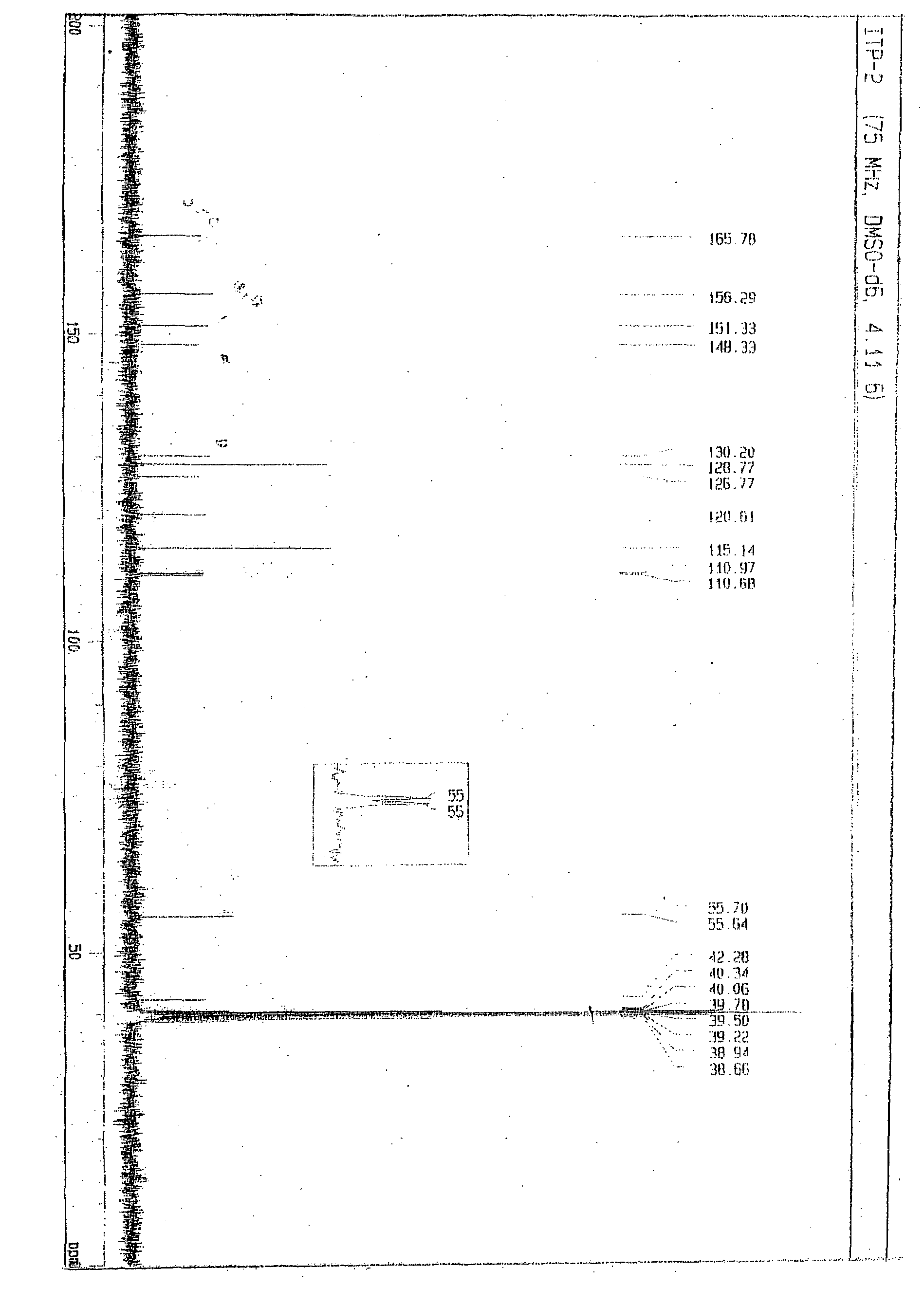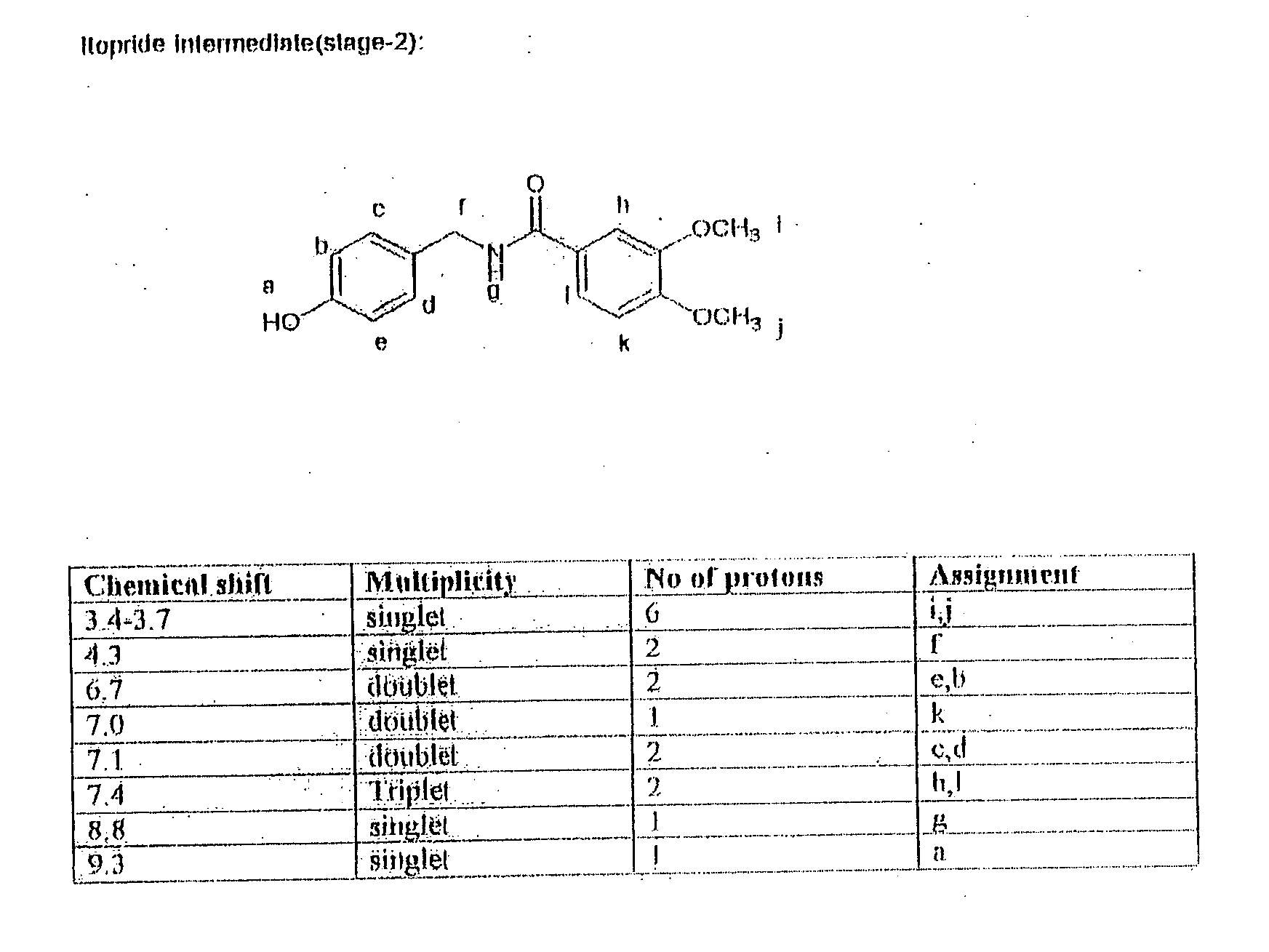Novel process for synthesis of itopride and its novel intermediate n-(4-hydroxybenzyl)- 3,4-dimethoxybenzamide
a technology of dimethylamino ethyl and n-(4-hydroxybenzyl)- 3,4-dimethoxybenzamide, which is applied in the field of process for synthesis of itopride and its novel intermediate, can solve the problems of increasing the consumption of dimethylaminoethanol/2-dimethylamino ethyl chlorid
- Summary
- Abstract
- Description
- Claims
- Application Information
AI Technical Summary
Benefits of technology
Problems solved by technology
Method used
Image
Examples
example-1
Preparation of P_Hydroxy Benzylamine
[0041]Methanol (2.0 L) is charged in an autoclave, p-hydroxybenzaldehyde (250 gms; 2.049M) is added followed by 25 gms (50 gms wet) of Raney Nickel, and aqueous ammonia (25%) (800 ml; 11.7647M). The hydrogenator is evacuated and flushed with nitrogen, a few times. The autoclave is initially pressurized to 3 Kg / cm2 with hydrogen and then maintained at 5 Kg / cm2 hydrogen pressure for 15-20 hours at 25-28° C. The reaction is monitored by TLC and continued till the starting material is less than 2%. After releasing hydrogen pressure, the reaction mixture is further heated for 30 minutes at about 40° C. The catalyst is filtered and washed with methanol, followed by purging of the solution with nitrogen for about one hour till the evolution of ammonia ceases. The solvent is distilled off at 40-45° C. to ¼ of the total volume under vacuum, cooled to 0° C. and stirred for two hours. The solid is filtered and the cake is washed with 2×250 ml of water, follo...
example-2
Preparation of P_Hydroxy Benzylamine
[0046]Methanolic ammonia (13-15%) (700 ml) is charged into an autoclave, p-hydroxybenzaldehyde (100 gm; 0.82 moles) is charged followed by Raney Nickel (15 gms; 30 gms wet). The hydrogenator is evacuated and flushed with nitrogen, a few times. The autoclave is pressurized to 5 Kg / cm2 with hydrogen and maintained at 5 Kg / cm2 for 5-6 hours at 25-28° C. The reaction is monitored on HPLC and the reaction is continued till the starting material is less than 2%. Hydrogen pressure is released and the catalyst is filtered and washed with methanol. Nitrogen gas is purged in the solution for one hour till the evolution of ammonia gas ceases. The solvent is distilled off up to ⅓rd of the total volume under vacuum at 40-45° C. The reaction mass is cooled to 0° C. and stirred for two hours. The solid is filtered and washed with 2×100 ml of water, followed by 100 ml of methanol. The material is dried in oven at 50-55° C. under vacuum till the moisture content i...
example-3
Preparation of 3,4-Dimethoxy Benzoyl Chloride
[0050]Toluene (312 ml) is charged in a 1 L 4 neck RBF fitted with magnetic stirrer thermowel, water condenser and calcium chloride guard tube. 3,4-dimethoxy benzoic acid (78 gms; 0.4286 moles) is charged followed by N,N-dimethylformamide (3 ml). The reaction mass is heated with stirring to 40° C. Thionyl chloride, 38 ml (61.18 gms, 05143 moles) is added at 40° C. over a period of 30 minutes. The reaction mixture is heated to 50-55° C. and stir for 2 hours. The reaction is monitored by TLC. After the reaction is complete, the solvent is distilled off completely. The product is directly taken for next stage considering the yield as 98%.
PUM
| Property | Measurement | Unit |
|---|---|---|
| Temperature | aaaaa | aaaaa |
| Temperature | aaaaa | aaaaa |
Abstract
Description
Claims
Application Information
 Login to View More
Login to View More - R&D
- Intellectual Property
- Life Sciences
- Materials
- Tech Scout
- Unparalleled Data Quality
- Higher Quality Content
- 60% Fewer Hallucinations
Browse by: Latest US Patents, China's latest patents, Technical Efficacy Thesaurus, Application Domain, Technology Topic, Popular Technical Reports.
© 2025 PatSnap. All rights reserved.Legal|Privacy policy|Modern Slavery Act Transparency Statement|Sitemap|About US| Contact US: help@patsnap.com



